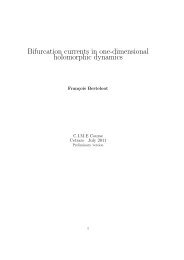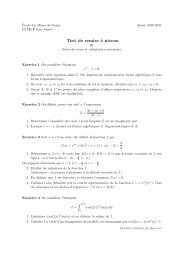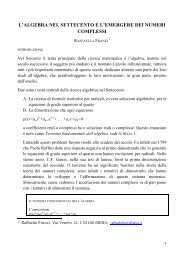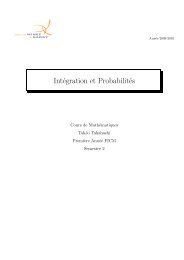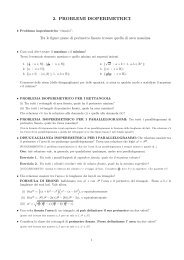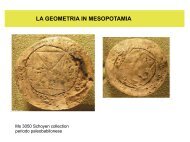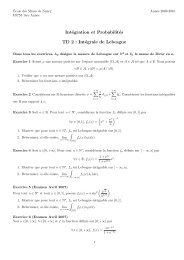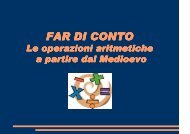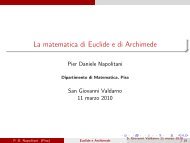Derivation of a fundamental diagram for urban traffic flow
Derivation of a fundamental diagram for urban traffic flow
Derivation of a fundamental diagram for urban traffic flow
You also want an ePaper? Increase the reach of your titles
YUMPU automatically turns print PDFs into web optimized ePapers that Google loves.
D. Helbing: <strong>Derivation</strong> <strong>of</strong> a <strong>fundamental</strong> <strong>diagram</strong> <strong>for</strong> <strong>urban</strong> <strong>traffic</strong> <strong>flow</strong> 5<br />
It also makes sense to define an efficiencies not only <strong>for</strong> the<br />
<strong>traffic</strong> phases, but also <strong>for</strong> the operation <strong>of</strong> a <strong>traffic</strong> light<br />
(i.e. the full cycle). This can be done by averaging over<br />
all efficiencies ɛ i (and potentially weighting them by the<br />
number u i ̂Qi T cyc <strong>of</strong> vehicles arriving in one cycle. There<strong>for</strong>e,<br />
it makes sense to define the intersection efficiency as<br />
ɛ =<br />
∑<br />
i ɛ iu i ̂Qi<br />
∑i u i ̂Q i<br />
. (30)<br />
Note that, particularly in cases <strong>of</strong> pulsed rather than uni<strong>for</strong>m<br />
arrivals <strong>of</strong> vehicles, the efficiencies ɛ i depend on the<br />
cycle time T cyc and, there<strong>for</strong>e, also on the utilizations u i .<br />
Increasing the efficiency ɛ i <strong>for</strong> one <strong>traffic</strong> stream i will <strong>of</strong>ten<br />
(but not generally) reduce the efficiency ɛ j <strong>of</strong> another<br />
<strong>traffic</strong> stream j, which poses a great challenge to <strong>traffic</strong><br />
optimization.<br />
The exact value <strong>of</strong> the efficiency ɛ i depends on many<br />
details such as the time-dependence <strong>of</strong> the arrival <strong>flow</strong><br />
A i (t) and its average value A i , the length L i <strong>of</strong> the road<br />
section, and the signal control scheme (fixed cycle time<br />
or not, adaptive green phases or not, signal <strong>of</strong>fsets, etc.).<br />
These data and the exact signal settings are <strong>of</strong>ten not fully<br />
available and, there<strong>for</strong>e, it is reasonable to consider ɛ i as<br />
fit parameters rather than deriving complicated <strong>for</strong>mulas<br />
<strong>for</strong> them. Nevertheless, we will demonstrate the general<br />
dependence on the utilization u i in the following.<br />
For this, we will study the case <strong>of</strong> excess green times<br />
(δ i > 0), which are usually chosen to cope with the<br />
stochasticity <strong>of</strong> vehicle arrivals, i.e. the fact that the number<br />
<strong>of</strong> vehicles arriving during one cycle time is usually<br />
fluctuating. The choice δ i > 0, i.e. f i >u i , also implies<br />
A i T cyc<br />
T cyc<br />
= u i ̂Qi 0maybe<br />
derived from equations (21) and(28). We obtain<br />
1 − ɛ i = (1 − f i) 2<br />
(1 − u i ) 2 (1 − ∑ j u j)<br />
(1 − ∑ j f j) , (32)<br />
where f i (u i ,δ i )=(1+δ i )u i according to equation (7).<br />
The efficiency ɛ i is usually smaller than in the case, where<br />
the <strong>traffic</strong> light is turned red as soon as a vehicle queue<br />
has been dissolved (<strong>for</strong> exceptions see Ref. [41]). Then,<br />
ɛ i < 0<strong>for</strong>δ i > 0. Formula (32) also allows one to treat the<br />
case where the green time fractions f i and the cycle time<br />
T cyc are not adapted to the respective <strong>traffic</strong> situation,<br />
but where a fixed cycle time T cyc = Tcyc 0 andfixedgreen<br />
time fractions fi<br />
0 are implemented. This corresponds to<br />
constant green times<br />
fi 0 Tcyc({f 0 j 0 }) =<br />
f i 0T los<br />
1 − ∑ j f j<br />
0 . (33)<br />
In case <strong>of</strong> uni<strong>for</strong>m vehicle arrivals, we just have to insert<br />
the corresponding value f i = f 0 i into equation (32) to<br />
obtain ɛ i . In the case <strong>of</strong> non-uni<strong>for</strong>m arrivals, ɛ i can be<br />
understood as fit parameter <strong>of</strong> our model, which allows us<br />
to adjust our <strong>for</strong>mulas to empirical data and to quantify<br />
the efficiency <strong>of</strong> <strong>traffic</strong> light operation. In this way, we<br />
can also absorb effects <strong>of</strong> stochastic vehicle arrivals into<br />
the efficiency coefficients ɛ i , which simplifies our treatment<br />
alot.<br />
3 Fundamental relationships<br />
<strong>for</strong> undersaturated <strong>traffic</strong><br />
The travel time is generally given by the sum <strong>of</strong> the free<br />
travel time Ti 0 = L i /Vi<br />
0 and the average delay time Ti av ,<br />
where L i denotes the length <strong>of</strong> the road section used by<br />
vehicle stream i and Vi<br />
0 the free speed (or speed limit).<br />
With equation (24), we get<br />
T i ({u j },ɛ i )=T 0<br />
i<br />
+ T av<br />
i<br />
({u j },ɛ i )= L av<br />
i ΔNi ({u j },ɛ i )<br />
Vi<br />
0 + .<br />
u i ̂Qi<br />
(34)<br />
Inserting equation (29), we can express the travel time<br />
solely in terms <strong>of</strong> the utilization u i , and we have<br />
T i ({u j },ɛ i )= L i<br />
Vi<br />
0 +(1− ɛ i ) (1 − u i)T los<br />
2(1 − ∑ j u j) . (35)<br />
The <strong>for</strong>mula (35) constitutes a <strong>fundamental</strong> relationship<br />
between the average travel time Ti<br />
av on the capacity utilization<br />
u i under the assumptions made (mainly cyclical<br />
operation with certain efficiencies ɛ i ). Of course, one still<br />
needs to specify the factor (1 − ɛ i ). In case <strong>of</strong> constant arrival<br />
rates A i ,thisfactorisgivenbyequation(32), which<br />
finally results in<br />
T i (u i , {f j })= L i<br />
Vi<br />
0 + (1 − f i) 2<br />
(1 − u i )<br />
After insertion <strong>of</strong> equation (7), we get<br />
T i ({u j }, {δ j })= L i<br />
V 0<br />
i<br />
T los<br />
2(1 − ∑ j f j) . (36)<br />
[1 − (1 + δ i )u i ] 2 T los<br />
+<br />
(1 − u i )2[1 − ∑ j (1 + δ j)u j ] . (37)<br />
Sometimes, it is desireable to express the <strong>fundamental</strong> relationships<br />
in terms <strong>of</strong> the density rather than the utility.<br />
Inserting equation (35) intoTi<br />
av (u i ,ɛ i )=T i (u i ,ɛ i ) −<br />
L i /Vi 0 , and this into equation (26), we obtain the equation<br />
ρ av<br />
i<br />
({u j },ɛ i ,L i )= u i ̂Q i<br />
(1 − ɛ i ) (1 − u i)T los<br />
L i 2(1 − ∑ j u j) , (38)<br />
which can be numerically inverted to give the utilization u i<br />
as a function <strong>of</strong> the scaled densities ρ av<br />
j L j/(1−ɛ j ). The calculations<br />
are simpler in case <strong>of</strong> a fixed cycle time Tcyc 0 and<br />
an uni<strong>for</strong>m arrival <strong>of</strong> vehicles. By inserting equation (20)



